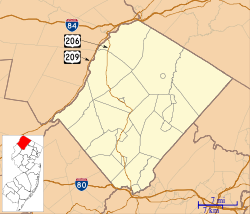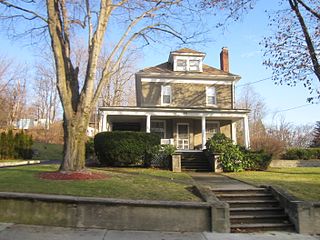
Franklin is a borough in Sussex County, in the U.S. state of New Jersey. As of the 2020 United States census, the borough's population was 4,912, a decrease of 133 (−2.6%) from the 2010 census count of 5,045, which in turn reflected a decline of 115 (−2.2%) from the 5,160 counted in the 2000 census.

Ogdensburg is a borough in Sussex County, in the U.S. state of New Jersey. As of the 2020 United States census, the borough's population was 2,258, a decrease of 152 (−6.3%) from the 2010 census count of 2,410, which in turn reflected a decline of 228 (−8.6%) from the 2,638 counted in the 2000 census.

Sphalerite is a sulfide mineral with the chemical formula (Zn,Fe)S. It is the most important ore of zinc. Sphalerite is found in a variety of deposit types, but it is primarily in sedimentary exhalative, Mississippi-Valley type, and volcanogenic massive sulfide deposits. It is found in association with galena, chalcopyrite, pyrite, calcite, dolomite, quartz, rhodochrosite, and fluorite.

Franklinite is an oxide mineral belonging to the normal spinel subgroup's iron (Fe) series, with the formula Zn2+Fe23+O4.
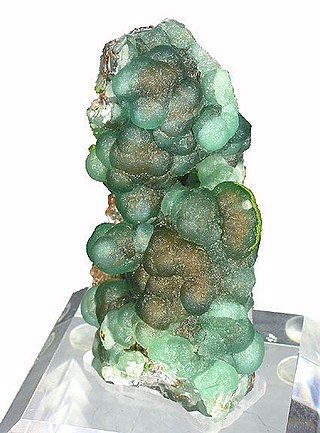
Willemite is a zinc silicate mineral and a minor ore of zinc. It is highly fluorescent (green) under shortwave ultraviolet light. It occurs in a variety of colors in daylight, in fibrous masses and apple-green gemmy masses. Troostite is a variant in which part of the zinc is partly replaced by manganese, it occurs in solid brown masses.
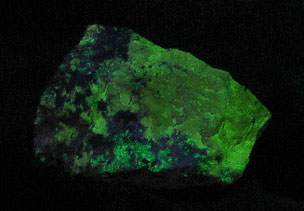
Esperite is a rare complex calcium lead zinc silicate (PbCa3Zn4(SiO4)4) related to beryllonite and trimerite that used to be called calcium larsenite. It was named in honor of Esper F. Larsen Jr. (1879–1961), petrologist of Harvard University.

Hardystonite is a rare calcium zinc silicate mineral first described from the Franklin, New Jersey, U.S. zinc deposits. It often contains lead, which was detrimental to the zinc smelting process, so it was not a useful ore mineral. Like many of the famous Franklin minerals, hardystonite responds to short wave ultraviolet light, emitting a fluorescence from dark purple to bright violet blue. In daylight, it is white to gray to light pink in color, sometimes with a vitreous or greasy luster. It is very rarely found as well formed crystals, and these are usually rectangular in appearance and rock-locked.
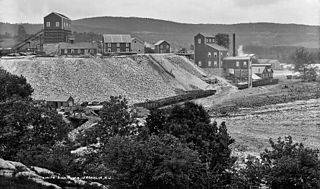
Franklin Furnace, also known as the Franklin Mine, is a famous mineral location for rare zinc, iron, manganese minerals in old mines in Franklin, Sussex County, New Jersey, United States. This locale produced more species of minerals and more different fluorescent minerals than any other location. The mineral association (assemblage) from Franklin includes willemite, zincite and franklinite.

The Southeast Missouri Lead District, commonly called the Lead Belt, is a lead mining district in the southeastern part of Missouri. Counties in the Lead Belt include Saint Francois, Crawford, Dent, Iron, Madison, Reynolds, and Washington. This mining district is the most important and critical lead producer in the United States.

The Sullivan Mine is a now-closed conventional–mechanized underground mine located in Kimberley, British Columbia, Canada. The ore body is a complex, sediment-hosted, sedimentary exhalative deposit consisting primarily of zinc, lead, and iron sulphides. Lead, zinc, silver and tin were the economic metals produced. The deposit lies within the lower part of the Purcell Supergroup and mineralization occurred about 1470 million years ago during the late Precambrian (Mesoproterozoic).
The Horsehead Holding Corporation, formerly The New Jersey Zinc Company, was an American producer of zinc and related materials based in Pittsburgh. The operations of the historic company are currently conducted as American Zinc Recycling.

In the United States, copper mining has been a major industry since the rise of the northern Michigan copper district in the 1840s. In 2017, the US produced 1.27 million metric tonnes of copper, worth $8 billion, making it the world's fourth largest copper producer, after Chile, China, and Peru. Copper was produced from 23 mines in the US. Top copper producing states in 2014 were Arizona, Utah, New Mexico, Nevada, and Montana. Minor production also came from Idaho, and Missouri. As of 2014, the US had 45 million tonnes of known remaining reserves of copper, the fifth largest known copper reserves in the world, after Chile, Australia, Peru, and Mexico.

The Leadville mining district, located in the Colorado Mineral Belt, was the most productive silver-mining district in the state of Colorado and hosts one of the largest lead-zinc-silver deposits in the world. Oro City, an early Colorado gold placer mining town located about a mile east of Leadville in California Gulch, was the location to one of the richest placer gold strikes in Colorado, with estimated gold production of 120,000–150,000 ozt, worth $2.5 to $3 million at the then-price of $20.67 per troy ounce.

The New Jersey State Museum is located at 195-205 West State Street in Trenton, in the U.S. state of New Jersey. The museum's collections include natural history specimens, archaeological and ethnographic artifacts, and cultural history and fine art objects. Exhibitions, educational activities, research programs, and lectures are also offered. The museum, a division of the New Jersey Department of State, includes a 140-seat planetarium and a 384-seat auditorium.
St. Joe Minerals Corporation was an American mining company. It was the United States largest producer of lead and zinc at the time of its merger with Fluor Corporation in 1981. The St. Joseph Lead Company was founded on March 25, 1864 by Lyman W. Gilbert, John E. Wylie, Edmund I. Wade, Wilmot Williams, James L. Dunham and James L. Hathaway in New York City.

Backwards Tunnel, also known as the Ogdensburg Railroad Arch, is located in Ogdensburg, Sussex County, New Jersey, United States. The tunnel was added to the National Register of Historic Places on December 28, 2005.
The Franklin Mineral Museum in Franklin, New Jersey is a mineral, geology, and mining museum at the former Franklin Mine. It is located in Sussex County, New Jersey.

The Edison Ore-Milling Company was a venture by Thomas Edison that began in 1881. Edison introduced some significant technological developments to the iron ore milling industry but the company ultimately proved to be unprofitable. Towards the end of the company's life, Edison realized the potential application of his technologies to the cement industry and formed the Edison Portland Cement Company in 1899.
Sterling Hill is a mountain in Sussex County, New Jersey. The peak rises to 833 feet (254 m), and overlooks the Wallkill River and Ogdensburg to the southeast. It is part of the Pimple Hills.

Zinc mining in the United States produced 780,000 tonnes of zinc in 2019, making it the world's fourth-largest zinc producer, after China, Australia, and Peru. Most US zinc came from the Red Dog mine in Alaska. The industry employed about 2,500 in mining and milling, and 250 in smelting.

